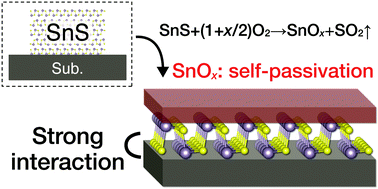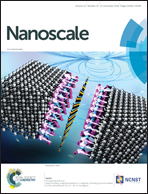Self-passivated ultra-thin SnS layers via mechanical exfoliation and post-oxidation†
Abstract
Remarkable optical/electrical features are expected in two-dimensional group-IV monochalcogenides (MXs; M = Sn/Ge and X = S/Se) with a uniquely distorted layered structure. The lone pair electrons in the group-IV atoms are the origin of this structural distortion, while they also cause a strong interlayer force and high chemical reactivity. The fabrication of chemically stable few-to-monolayer MX has been a significant challenge. We have observed that, once the SnS surface is oxidized, the SnOx top layer works as a passivation layer for the SnS layer underneath. In this work, the SnOx/SnS hetero-structure is studied structurally, optically, and electrically. When tape-exfoliated bulk SnS is oxygen-annealed under a reduced pressure at 10 Pa, surface oxidation and SnS sublimation proceed simultaneously, resulting in a monolayer-thick SnS layer with the SnOx passivation layer. The field-effect transistor of nine-layer SnS prepared via mechanical exfoliation exhibits a p-type characteristic because of intrinsic Sn vacancies, whereas ambipolar behavior is observed for the monolayer-thick SnS obtained via oxygen annealing probably owing to the additional n-type doping by S vacancies. This work on monolayer-thick SnS fabrication can be applied to other unstable lone pair analogues and can facilitate future research on MXs.



 Please wait while we load your content...
Please wait while we load your content...